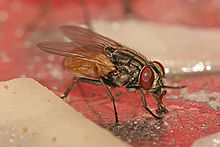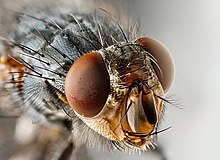This is an old revision of this page, as edited by Stemonitis (talk | contribs) at 14:33, 22 December 2009 (remove excess taxonomy and redundant category (but add family!); add date category; format refs.; etc.). The present address (URL) is a permanent link to this revision, which may differ significantly from the current revision.
Revision as of 14:33, 22 December 2009 by Stemonitis (talk | contribs) (remove excess taxonomy and redundant category (but add family!); add date category; format refs.; etc.)(diff) ← Previous revision | Latest revision (diff) | Newer revision → (diff)
| This article needs additional citations for verification. Please help improve this article by adding citations to reliable sources. Unsourced material may be challenged and removed. Find sources: "Housefly" – news · newspapers · books · scholar · JSTOR (February 2008) (Learn how and when to remove this message) |
| Housefly | |
|---|---|

| |
| A housefly feeding with its tubelike mouthparts | |
| Conservation status | |
| Least Concern | |
| Scientific classification | |
| Kingdom: | Animalia |
| Phylum: | Arthropoda |
| Class: | Insecta |
| Order: | Diptera |
| Section: | Schizophora |
| Family: | Muscidae |
| Genus: | Musca |
| Species: | M. domestica |
| Binomial name | |
| Musca domestica Linnaeus, 1758 | |
| Subspecies | |
| |
The housefly (also house fly, house-fly or common housefly), Musca domestica, is a Diptera of the Brachycera suborder. It is the most common of all domestic flies, accounting for about 90% of all flies in human habitations, and indeed one of the most widely distributed insects, found all over the world; it is considered a pest that can carry serious diseases.
Physical description


The adults are 8–12 mm long. Their thorax is gray, with four longitudinal dark lines on the back. The underside of their abdomen is yellow, and their whole body is covered with hair-like projections. The females are slightly larger than the males, and have a much larger space between their red compound eyes. The mass of pupae can range from about 8 to 20 mg under different conditions.
Like other Diptera (meaning "two-winged"), houseflies have only one pair of wings; the hind pair is reduced to small halteres that aid in flight stability. Characteristically, the media vein (M1+2 or fourth long vein of the wing) shows a sharp upward bend.
Species that appear similar to the housefly include:
- The lesser house fly, Fannia canicularis, is somewhat smaller, more slender, and the media vein is straight.
- The stable fly, Stomoxys calcitrans, has piercing mouthparts and the media vein is only slightly curved.
Life cycle
Each female fly can lay approximately 500 eggs in several batches of about 75 to 150 . The eggs are white and are about 1.2 mm in length. Within a day, larvae (maggots) hatch from the eggs; they live and feed in (usually dead and decaying) organic material, such as garbage or feces. They are pale-whitish, 3–9 mm long, thinner at the mouth end, and have no legs. They live at least one week. At the end of their third instar, the maggots crawl to a dry cool place and transform into pupae, colored reddish or brown and about 8 mm long. The adult flies then emerge from the pupae. (This whole cycle is known as complete metamorphosis.) The adults live from two weeks to a month in the wild, or longer in benign laboratory conditions. After having emerged from the pupae, the flies cease to grow; small flies are not young flies, but are indeed the result of getting insufficient food during the larval stage.

Some 36 hours after having emerged from the pupa, the female is receptive for mating. The male mounts her from behind to inject sperm. Copulation takes between a few seconds to a couple of minutes. Normally the female mates only once, storing the sperm to use it repeatedly for laying several sets of eggs. Males are territorial: they will defend a certain territory against other males and will attempt to mount any females that enter that territory.


The flies depend on warm temperatures; generally, the warmer the temperature the faster the flies will develop. In winter, most of them survive in the larval or the pupa stage in some protected warm location.
Diet
Houseflies feed on feces, open sores, sputum, and moist decaying organic matter such as spoiled food, eggs and flesh. Houseflies can take in only liquid foods. They spit out saliva on solid foods to predigest it, and then suck it back in. They also regurgitate partly digested matter and pass it again to the abdomen.
Sex determination
The housefly is an object of biological research, mainly because of one remarkable quality: the sex determination mechanism. Although a wide variety of sex determination mechanisms exist in nature (e.g. male and female heterogamy, haplodiploidy, environmental factors) the way sex is determined is usually fixed within one species. However, the housefly exhibits many different mechanisms for sex determination, such as male heterogamy (like most insects and mammals), female heterogamy (like birds) and maternal control over offspring sex. This makes the housefly one of the most suitable species to study the evolution of sex determination.
Evolution
Even though the order of flies (Diptera) is much older, true houseflies are believed to have evolved in the beginning of the Cenozoic era, some 65 million years ago. House flies feed on liquid or semi-liquid substances beside solid material which has been softened by saliva or vomit. Because of their high intake of food, they deposit feces constantly, one of the factors that makes the insect a dangerous carrier of pathogens. Although they are domestic flies, usually confined to the human habitations, they can fly for several miles from the breeding place. They are active only in daytime and rest at night e.g. at the corners of rooms, ceiling hangings, etc.
Housefly as a vector of disease
Mechanical transmission of organisms on its hairs, mouthparts, vomitus and feces:
- parasitic diseases: cysts of protozoa e.g. Entamoeba histolytica, Giardia lamblia and eggs of helminths e.g.: Ascaris lumbricoides, Trichuros trichura, Haemenolypes nana, Enterobius vermicularis.
- bacterial diseases: typhoid, cholera, dysentery, pyogenic cocci...etc. House flies have been demonstrated to be vectors of Campylobacter and E. coli O157:H7 using PCR . House flies can be monitored for bacterial pathogens using filter paper spot cards and PCR
- Viruses: enteroviruses: poliomyelitis, infective hepatitis (A & E)..etc
As a causative agent of diseases
Accidental myiasis
References
-
Larraín, Patricia & Salas, Claudio (2008). "House fly (Musca domestica L.) (Diptera: Muscidae) development in different types of manure ". Chilean Journal of Agricultural Research. 68: 192–197. doi:10.4067/S0718-58392008000200009. ISSN 0718-5839.
{{cite journal}}: CS1 maint: multiple names: authors list (link) - Stuart M. Bennett (2003). "Housefly".
- ^ Anthony DeBartolo (June 5, 1986). "Buzz off! The housefly has made a pest of himself for 25 million years". Chicago Tribune.
- Adapted from Dewey M. Caron (1999). "House flies". University of Rhode Island.
- Dübendorfer A, Hediger M, Burghardt G, Bopp D. (2002). "Musca domestica, a window on the evolution of sex-determining mechanisms in insects". International Journal of Developmental Biology. 46 (1): 75–79.
{{cite journal}}: CS1 maint: multiple names: authors list (link) - Brian M. Wiegmann, David K. Yeates, Jeffrey L. Thorne, Hirohisa Kishino, a fly's head, showing compound eyes and hair
- A. L. Szalanski, C. B. Owens, T. Mckay & C. D. Steelman (2004). "Detection of Campylobacter and Escherichia coli O157:H7 from filth flies by polymerase chain reaction". Medical and Veterinary Entomology. 18: 241–246. doi:10.1111/j.0269-283X.2004.00502.x.
{{cite journal}}: CS1 maint: multiple names: authors list (link) - Sheri M. Brazil, C. Dayton Steelman & Allen L. Szalanski (2007). "Detection of pathogen DNA from filth flies (Diptera: Muscidae) using filter paper spot cards". Journal of Agricultural and Urban Entomology. 24 (1): 13–18. doi:10.3954/1523-5475-24.1.13.
External links
- house fly on the UF / IFAS Featured Creatures Web site
- Many annotated images
- Pictorial presentation of life-cycle
- The House Fly and How to Suppress It, by L. O. Howard and F. C. Bishopp. U. S. Department of Agriculture Bulletin No. 1408, 1928, from Project Gutenberg. Also see:
- Stockbridge, Frank Parker (1912). "How To Get Rid Of Flies: The Way They "Swat" Them In Topeka And Order Out The Boy Scouts To Slaughter Them". The World's Work: A History of Our Time. XXIII: 692–701.
{{cite journal}}:|access-date=requires|url=(help); Cite has empty unknown parameter:|coauthors=(help); External link in|title=|month=ignored (help) - Page (editor), Walter Hines (1912). "How To Make A Flyless Town". The World's Work: A History of Our Time. XXIV: 176–179.
{{cite journal}}:|access-date=requires|url=(help);|last=has generic name (help); Cite has empty unknown parameter:|coauthors=(help); External link in|title=|month=ignored (help)
- Stockbridge, Frank Parker (1912). "How To Get Rid Of Flies: The Way They "Swat" Them In Topeka And Order Out The Boy Scouts To Slaughter Them". The World's Work: A History of Our Time. XXIII: 692–701.
- Video: Common Housefly 60x enlarged and alive under microscope.